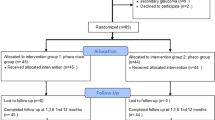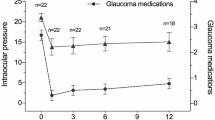Abstract
Purpose
To assess potential problems in monitoring glaucoma status in pseudophakic patients in whom the intraocular lens (IOL) has undergone varying degrees of opacification.
Methods
Data was collected by retrospective review of the notes of such patients, who had received a hydrophilic acrylic IOL, SC-60B-0UV, after primary cataract extraction by phacoemulsification. At first, among these, patients with glaucoma were identified and notes were reviewed to identify problems with patients in whom the IOL had undergone varying degrees of opacification.
Results
A total of 32 eyes with glaucoma were identified to have received the SC-60B-0UV IOL. Of these, 13 IOLs (40.6%) had undergone varying degrees of opacification. Eyes with the opacified IOLs showed decreased visual acuity (2.5 lines of Snellen acuity on average). For these eyes, visual field performance (as determined on automated field analyzers) and optic disc assessments were adversely affected giving a false impression of advanced glaucomatous field loss.
Conclusion
In our experience, glaucoma monitoring is made comparatively more difficult in pseudophakic patients with cloudy IOLs. Problems are encountered during assessment of the glaucomatous optic disc due to poor view of the optic disc. On standard static automated visual fields, these opacified IOLs produce artefactual visual field defects making monitoring glaucoma and subsequent management more difficult.
Similar content being viewed by others
Log in or create a free account to read this content
Gain free access to this article, as well as selected content from this journal and more on nature.com
or
References
Frohn A, Dick HB, Augustin AJ, Grus FH . Late opacification of the foldable hydrophilic acrylic lens SC-60-0UV. Ophthalmology 2001; 108: 1999–2004.
Werner L, Apple DJ, Kaskaloglu M, Pandey SK . Dense opacification of the optical component of a hydrophilic acrylic intraocular lens. J Cataract Refract surg 2001; 27: 1485–1492.
The AGIS Investigators. The advanced glaucoma intervention study, 6: effect of cataract on visual field and visual acuity. Arch Ophthalmol 2000; 118(12): 1639–1652.
Smith SD, Katz J, Quigley HA . Effect of cataract extraction on the results of automated perimetry in glaucoma. Arch Ophthalmol 1997; 115(12): 1515–1519.
Hayashi K, Hayashi H, Nakao F, Hayashi F . Influence of cataract surgery on automated perimetry in patients with glaucoma. Am J Ophthalmol 2001; 132(1): 41–46.
Heider HW, Seez KJ, Schnaudigel OE . Changes in the visual field caused by lens opacities. Klin Monatsbl Augenheilkd 1991; 198(1): 15–19.
Taney I, Taney V . Correlation between changes in the nerve fiber layer and examination of the visual field using automatic perimetry in diagnosing primary open angle glaucoma. J Fr Ophtalmol 2002; 25(9): 936–939.
Halikiopoulos D, Moster MR, Azuara-Blanco A, Wilson RP, Schmidt G, Spaeth GL et al. The outcome of the functioning filter after subsequent cataract extraction. Ophthalmic Surg Lasers 2001; 32(2): 108–117.
Rebolleda G, Munoz-Negrete FJ . Phacoemulsification in eyes with functioning filtering blebs: a prospective study. Ophthalmology 2002; 109(12): 2248–2255.
Author information
Authors and Affiliations
Corresponding author
Rights and permissions
About this article
Cite this article
Saeed, M., Sheikh, I. & Jafree, A. Glaucoma monitoring in patients with a ‘pseudophakic cataract’. Eye 19, 1208–1212 (2005). https://doi.org/10.1038/sj.eye.6701747
Received:
Accepted:
Published:
Issue date:
DOI: https://doi.org/10.1038/sj.eye.6701747



